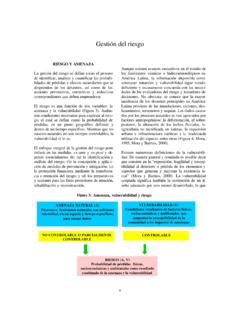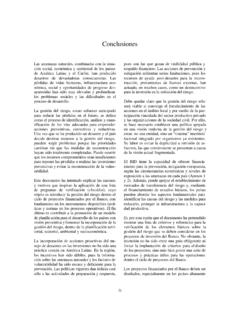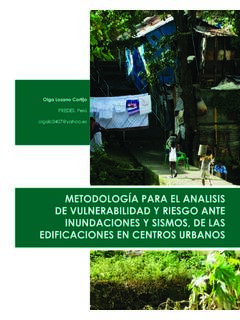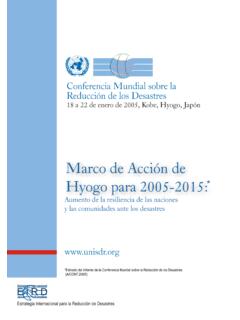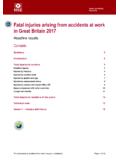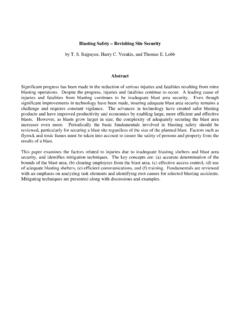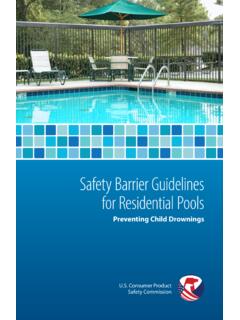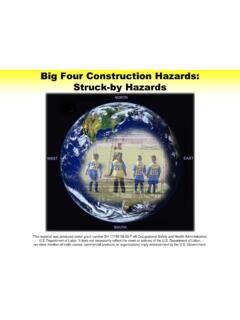Transcription of Natural Disasters and the Impacts on Health Report
1 1 Natural Disasters and the Impacts on Health Gerard March The University of Western Ontario Faculty of Medicine and Dentistry Summer Student with ICLR - 2002 1. INTRODUCTION A Natural disaster is defined as an event of nature, which overwhelms local resources and threatens the function and safety of the community. Generally, Disasters are the ultimate test of a community s emergency response capability. A thoughtful and well-organised emergency strategy will be able to quickly adjust and adapt to unforeseen situations and complications. (1) An emergency strategy that is myopic and static in nature is doomed to fail as the disaster situation grows, becoming both complex and unpredictable. Disasters are difficult to plan and anticipate because they are innately different from common emergency events. While it is true that both can lead to large amounts of casualties and property damage, the difference between a disaster and a common emergency event is more than one of magnitude alone.
2 A disaster challenge cannot be overcome by mobilising more personnel or materials. In order for a community to survive a catastrophe scenario, a disaster plan that is adaptable to multi-disciplinary and multi-jurisdictional situations is needed. (2) Large scale Disasters can have a multitude of effects upon a community: from economic to social, from physical to psychological. This Report will attempt to catalogue and briefly discuss the immediate medical and long-term Health effects of a Natural disaster. Other topics such as the disruption of a community s critical infrastructure, vulnerable groups within populations, and common misconceptions in disaster response will also be reviewed. Finally, mitigation and loss reduction strategies will be introduced in the context of injury prevention and promotion of Health benefits. 2. THE IMMEDIATE EFFECTS OF Natural Disasters TRAUMA AND INJURY Natural Disasters are complicated events within which people are subjected to a multitude of risks and dangers.
3 Every disaster scenario is unique in its own way and presents new and unusual challenges to victims and rescue emergency personnel alike. On one hand, each disaster must be evaluated independently of past events in order to recognise the special features of the situation at hand. In this manner, one avoids the common mistake of preparing for the last disaster situation as opposed to anticipating the next one. On the other hand, certain disaster situations do follow general patterns and develop along similar paths. It is vital to appreciate these subtle patterns in order to provide community planners and allied Health professionals with a foundation to design a comprehensive emergency response plan. (3) A fine balance must be maintained between learning from the mistakes and lessons of the past, and resisting the temptation of simply approaching a situation the way it has always been done . (4) Generally speaking, certain Disasters lead to certain types of injuries more than others.
4 This can be an important fact to bear in mind when planning an emergency response, taking stock of available medical supplies, or estimating the needs of a community or geographical area. (4) It is crucial, however, to be conscious that injury types are not exclusive to any one situation. Indeed 2the sheer scale and complexity of a Natural disaster may lead to many smaller disaster situations; each one with its own individual characteristics and challenges. (5) An example of a large scale catastrophe causing many smaller emergencies situations is a large scale flood which in turn causes a chemical spill from a water logged factory, a landslide burying several homes, drinking water reservoir contamination, and the collapse of a downtown building. As a basis for planning, it is nevertheless useful to consider the types of injuries the majority of the victims will incur in order to evaluate the immediate needs of the disaster response team.
5 Droughts The immediate emergency effects of a drought are subtle when compared to those brought on by Natural Disasters such as tornadoes or hurricanes. In a region that has been severely affected by a drought, mortality may increase sharply due to protein malnutrition (kwashiorkor) or calorie malnutrition (marasmus). Certain vitamin deficiencies, such as a lack of Vitamin A, can lead to specific consequences such as xerpohthalmia and child blindness. Long standing malnutrition can easily lead to increased rates of disease and mortality, and limit the general population s functionality. (6) In some cases, mass movements of people spurred by long-standing drought and food shortages can lead to over-crowding and collectively poor hygiene. Over-crowding can easily lead to an increase in the transmission rates of communicable diseases such as tuberculosis or gastro-intestinal infections. (7) Earthquakes Earthquakes induce a high level of mortality due to crush injuries from falling objects.
6 The greatest risk of injury from an earthquake is either indoors or in close proximity to buildings and other structures. The risk of injury in open areas such as fields or in the countryside is very low. (4) Furthermore, injury severity is inversely related to the distance from the epicentre of the earthquake. injuries and deaths are generally increased with the magnitude of the earthquake, increased ground motion, and structural damage. (8) If an earthquake occurs at night, there is a greater incidence of trauma to the pelvis, thorax, and spine. This is because most victims are lying down in bed at the time of the disaster. These injuries commonly lead to severe damage to internal organs coinciding with severe internal bleeding. If the earthquake occurs during the daytime, it is more common to see injuries of the extremities with comorbid lacerations, severe external bleeding, and crush injuries including rhabdomyolysis and compartment syndrome.
7 Additionally, since most victims are standing or sitting down, most injuries during a diurnal earthquake occur to the skull and the collarbone because of falling debris. (4) Victims that have been trapped in fallen rubble for hours or possibly days run the risk of having infected wounds and/or gangrene. Common trauma procedures that need to be urgently addressed include amputations, vascular stabilisation, faciotomies, orthopedic stabilisation, and debridement and/or dressing of severe open wounds. It is important to note that patients who suffer from crush injuries also run a high risk of developing hypovolemic shock, hyperkalemia, renal failure, and have a greater chance of having a fatal cardiac arrhythmia or myocardial infarct. (3) While most of the trauma in an earthquake is a direct result of falling debris or collapsing structures, fire is another major concern within the first golden 24 hours after the disaster.
8 Depending on the size and extent of the fires, burn injuries , as well as respiratory problems due to smoke inhalation can quickly become a major strain on the medical system after an earthquake. (3) 3 Fires While ninety percent of the forest fires in the United States are caused by human action, Natural forest fires most often occur due to lightening strikes in dry and windy conditions. The greatest Health impact of a forest fire is, its effect on the surrounding air quality. Due to opportune local conditions, many smaller fires can contribute to poor air quality of one particular area. At the very best, the build up of smoke and pollutants in the air decreases visibility, and at the very worst it leads to new respiratory problems or exacerbates existing conditions. (7) Burn injuries from forest fires are uncommon but not unheard of. Burn injuries are most likely associated with members of the forest fire fighting crew who are commonly called upon to be in close proximity of large and unpredictable fires.
9 Depending on existing wind conditions, forest fires are able to spread rapidly and change direction quickly which can lead to the entrapment of fire fighters and, less commonly, private citizens. (7) Occasionally, within the context of a large forest fire animal attacks and/or bites also increase. Depending on the proximity of a forest fire to a population center, many wild animals, who have been forced to take flight, come into greater contact with humans. (9) This phenomenon, which is also seen in large floods, can lead not only to trauma from animal attacks, but more commonly increases the risk of zoonotic infections (infection passed from animals to humans). (10) Great fires that rage through urban areas are less common in developed countries due to the advent of a trained and equipped fire department. However, large-scale urban fires are still possible in the developing world, as well as secondary to other Natural Disasters such as an earthquake.
10 In 1906, a magnitude earthquake in the San Francisco area triggered major fires that eventually destroyed over 25,000 buildings and left 250,000 homeless. (11) injuries in a large-scale urban fire are more commonly burn injuries and deaths associated with asphyxiation. Common complications of burn injuries include hypovolemic shock as well as massive infection and sepsis. Floods The greatest risk of mortality from a flood is predictably drowning. In North America, floods account for more yearly weather deaths than all other Natural Disasters , with the exception of heat illnesses. The greatest number of deaths and injuries occur when there is little to no warning of an impending flood. This can occur in the case of flash flooding, the collapse of a dam, or from the action of a tidal wave due to a distant or even sub-oceanic earthquake. (12) Consistently, individuals underestimate the power of moving water leading to what could have been many preventable deaths and injuries .
